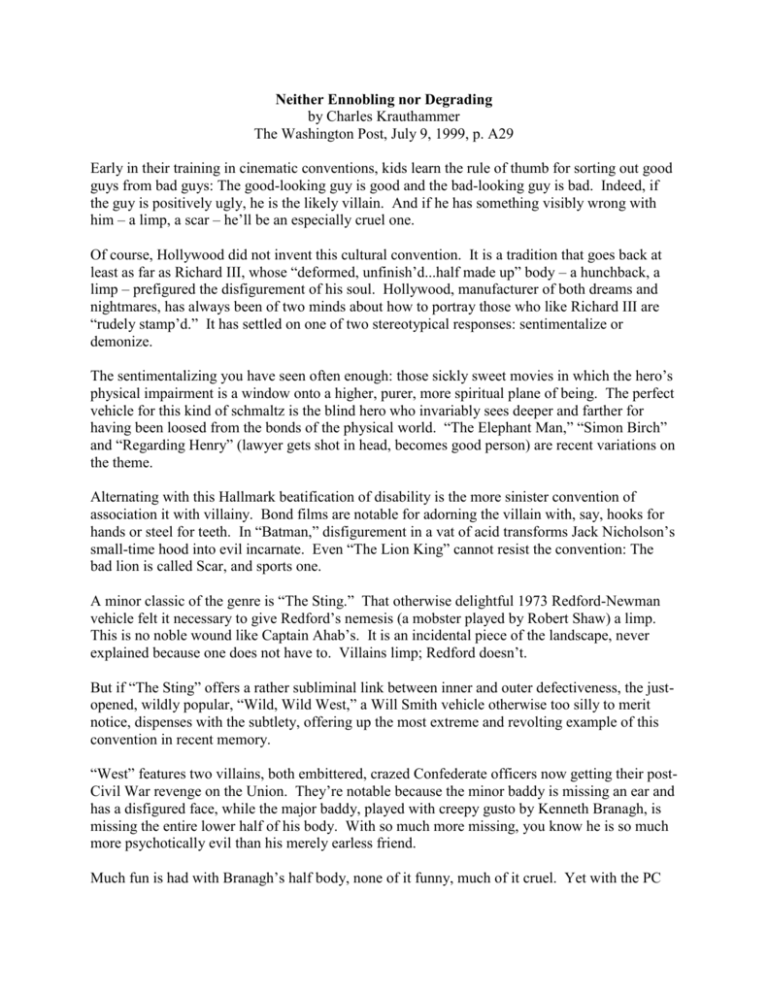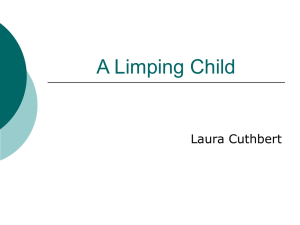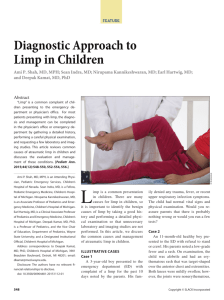Neither Ennobling nor Degrading
advertisement

Neither Ennobling nor Degrading by Charles Krauthammer The Washington Post, July 9, 1999, p. A29 Early in their training in cinematic conventions, kids learn the rule of thumb for sorting out good guys from bad guys: The good-looking guy is good and the bad-looking guy is bad. Indeed, if the guy is positively ugly, he is the likely villain. And if he has something visibly wrong with him – a limp, a scar – he’ll be an especially cruel one. Of course, Hollywood did not invent this cultural convention. It is a tradition that goes back at least as far as Richard III, whose “deformed, unfinish’d...half made up” body – a hunchback, a limp – prefigured the disfigurement of his soul. Hollywood, manufacturer of both dreams and nightmares, has always been of two minds about how to portray those who like Richard III are “rudely stamp’d.” It has settled on one of two stereotypical responses: sentimentalize or demonize. The sentimentalizing you have seen often enough: those sickly sweet movies in which the hero’s physical impairment is a window onto a higher, purer, more spiritual plane of being. The perfect vehicle for this kind of schmaltz is the blind hero who invariably sees deeper and farther for having been loosed from the bonds of the physical world. “The Elephant Man,” “Simon Birch” and “Regarding Henry” (lawyer gets shot in head, becomes good person) are recent variations on the theme. Alternating with this Hallmark beatification of disability is the more sinister convention of association it with villainy. Bond films are notable for adorning the villain with, say, hooks for hands or steel for teeth. In “Batman,” disfigurement in a vat of acid transforms Jack Nicholson’s small-time hood into evil incarnate. Even “The Lion King” cannot resist the convention: The bad lion is called Scar, and sports one. A minor classic of the genre is “The Sting.” That otherwise delightful 1973 Redford-Newman vehicle felt it necessary to give Redford’s nemesis (a mobster played by Robert Shaw) a limp. This is no noble wound like Captain Ahab’s. It is an incidental piece of the landscape, never explained because one does not have to. Villains limp; Redford doesn’t. But if “The Sting” offers a rather subliminal link between inner and outer defectiveness, the justopened, wildly popular, “Wild, Wild West,” a Will Smith vehicle otherwise too silly to merit notice, dispenses with the subtlety, offering up the most extreme and revolting example of this convention in recent memory. “West” features two villains, both embittered, crazed Confederate officers now getting their postCivil War revenge on the Union. They’re notable because the minor baddy is missing an ear and has a disfigured face, while the major baddy, played with creepy gusto by Kenneth Branagh, is missing the entire lower half of his body. With so much more missing, you know he is so much more psychotically evil than his merely earless friend. Much fun is had with Branagh’s half body, none of it funny, much of it cruel. Yet with the PC police so outraged at the alleged racism of George Lucas’s “Star Wars” – going so far as to locate, ridiculously, a Yiddish accent in Watto, the slave-owning merchant – it is rather odd that nothing has been said about the savage mockery of physical deformity in “West,” a blockbuster hit aimed squarely at kids. What makes it odder still is that this is the same Hollywood that routinely gives teary standing ovations every time Christopher Reeve makes an appearance at some awards ceremony. It is the same culture that falls over itself in soppy sentimental tributes to the “inspiration” that emanates from the disabled. Or maybe it is not so odd. The whole politically correct vogue for paying tribute to the “courage” and higher powers of the disabled – and of acquiescing to such comic linguistic conventions as calling the disabled “differently abled,” as if those of us in wheelchairs have chosen some alternate lifestyle – is, in the end, a form of condescension. To be sure, patronizing the disabled is not as offensive as the in-your-face mockery of something like “West.” But its effect is similar: to distance oneself, to give expression to the reflexive mixture of fear and pity that misfortune in others invokes in all of us. Disability – like exile, the human condition it most resembles – neither ennobles nor degrades. It frames experience. It does not define it. But that undramatic reality is hardly grist for Hollywood, which specializes in, and swings wildly between, fawning idealization and primitive caricature of disability. It is saint or sicko – now (as ever) playing at a theater near you.








